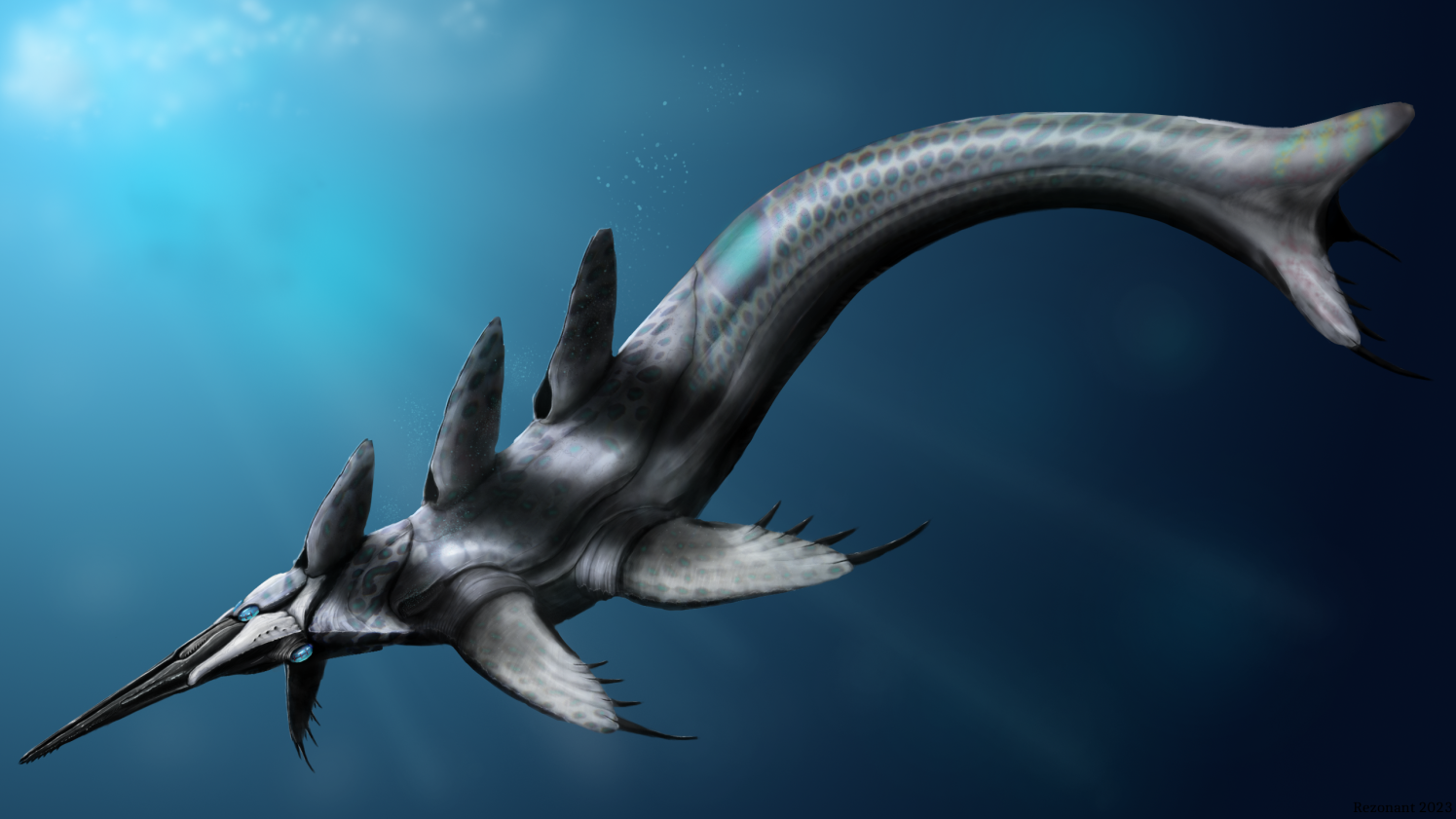
At the top of the food chain in Dra’Hynusian waters swims the Titan Scissorjaw. At 45 m (147 ft) and weighing nearly 300 tons, the species is almost twice the length of Earth’s Blue Whales and a decent chunk heavier; these leviathans are enough to make the most seasoned of seafarers fall to their knees just by their silhouette alone. Their 4m (13ft) long horizontally opening beak hides razor-sharp internal edges that they use to devastating effect in combination with their jaw muscles. Similar to Earth’s crocodilians, these muscles are fairly weak at opening but incredibly powerful upon closing, slicing through even thick bones in a single bite. Once prey has been dispatched, the smaller jaws inside, visible in front of the upper compound eyes, tear flesh into bite-sized chunks which are then drawn into the mouth via suction feeding.

Most unusual too are their dorsal fins which, upon closer inspection, aren’t dorsal fins at all. Three pairs of lateral fins hinged on modified spinal vertebrae fold upwards and press together while submerged to act as rudders. But when hunting megafauna close to the water’s edge, these fins can fold down against the body, allowing this giant to sneak up on prey without any dorsal fins betraying its presence by poking above the surface.
Behavior
Such a huge body and predatory lifestyle require a high amount of food to fuel it, and consequently, the Titan Scissorjaw spends 8 months of a Dra’Hynusian year hibernating in underwater caverns. When the largest prey items reach their peak numbers each year, the leviathan awakens to feast upon whatever it can find that is an easy kill (fortunately humans and submersible vehicles seem to be too small to be considered worth chasing down). But its clawed fins aid them in possibly their most bizarre hunting strategy so far observed.
Once a year, the largest land animals on its planet, the 15m (50ft) tall Shellshoulders, migrate from hemisphere to hemisphere to pursue specific types of vegetation. But a certain stretch of their migration path forces them to sleep for roughly two nights along a vast coastal stretch as jungles beyond the sand beaches are too dense for their large size to travel through. The leviathan will wait for these specific days to display their other planetary record; being the largest amphibious organism ever discovered.
Using their enormous muscular fins and claws to gain purchase on the beach, the fins under their head to prop their mouth upright, and their enormous finned tails like some sort of ghastly inchworm, they stealthily creep out of the water and slide along the sand to pick off sleeping Shellshoulders at the edge of the flock in the dark of night. Their countershading helps with their approach in these nocturnal hunts; their lighter top half blends in with moonlit ripples and reflections on the surface while the darker ventral coloration makes them harder to see against the night sky to aquatic fauna looking upwards
After killing terrestrial prey on land, they use the clawed fin limbs on their tail to grasp it and drag it back into the water, as their feeding method makes them incapable of swallowing food unless submerged.
After packing on the pounds for 4 months, reproduction occurs in the large underwater caves and caverns these animals frequent, and the female lays a single egg that is fertilized externally by the male. They rest on either side of the egg, which deters pretty much anything from attempting to feast upon it and gives the species an almost 100% successful hatch rate. The egg usually hatches within a week of the species’ activities resuming, and the newborn will be taught the basics of survival by its parents for about 2 months before leaving to start its own journey solo. Once a partner is found, however, this species is monogamous and pairs for life. The maximum lifespan has not been determined for this species but is estimated to be around 90 years.
This species was created by spec-evo artist and community member, Rezonant Void. You can check out more of his work here.